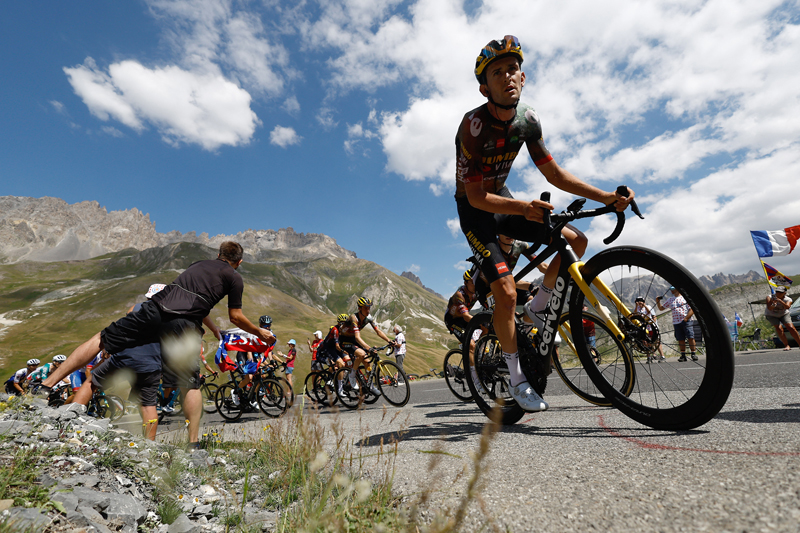The aerobic and anaerobic energy systems
Training the right energy system in relation to your sport will ensure optimum performance. By John Shepherd.
The three energy systems
1) Aerobic energy system
Distance running uses aerobic energy

Aerobic means ‘with air’.
Oxygen provides the catalyst for a chemical reaction in our muscles (including the heart) that generates aerobic energy. If it were not for other factors – such as insufficient muscle fuel (notably, carbohydrate or, more specifically, glycogen) over-heating and dehydration, we could theoretically continue to exercise aerobically indefinitely.
Aerobic workouts are often also called ‘steady state’. This is because, during them, the body’s energy demands are balanced by energy supply. This allows us to continuously exercise – hence the steady state. When the steady state is breached, for example, by increasing our effort and using more energy, our body will change the way it produces energy. It will do this with less oxygen and energy will be produced anaerobically – see below.
Whatever our sport, aerobic energy provides a base of fitness, regardless of the specific energy system demands of our actual sport. A good foundation will enable a sprinter (who relies predominantly on the immediate anaerobic system) to recover more quickly between training efforts or a football mid-fielder to sustain the high energy output required over a match (football relies particularly on the short-term anaerobic energy system). It should be noted that certain sports require more aerobic fitness than others, and others combinations of all three. Table 1, at the bottom of this article, provides a breakdown of the aerobic and anaerobic components of selected track and field events and sports.
Fat as a fuel source for the aerobic energy system
Although carbohydrate is the body’s preferred source of fuel during activity, fat also supplies energy. Aerobic training increases the body’s ability to mobilise fat as an energy source at sub-maximal intensities (as well as improving carbohydrate metabolism). This will significantly improve the ‘range’ of endurance athletes. To develop an improved fat burning capability you need to train religiously at about 80% of maximum heart rate (HRmax). This is known as ‘fat max’.
Two and three: the anaerobic energy systems

The anaerobic energy system is the energy system of choice for the 100m sprinter.
Anaerobic means without oxygen.
Our bodies can create anaerobic energy in two ways through the:
- immediate anaerobic energy system, and;
- short-term anaerobic energy system.
2) The immediate anaerobic energy system
When our bodies generate energy through the immediate anaerobic system, no reliance is placed on oxygen. Consequently, it supplies energy for no more than 6-8 seconds. To get its power it uses ‘high energy’ stored body chemicals – such as adenosine troposphere (ATP) and creatine phosphate (CP) and a chemical reaction that ‘fires’ them up.
Explosive energy
You might like to think of the immediate anaerobic energy system as being like an explosion. An incredible amount of energy is released in a very short time. From this you can appreciate that this is the energy system of choice for equally explosive athletes, such as power and weight lifters and sprinters.
Too much aerobic training can dull this explosiveness. It can reduce the power capability of our power and speed generating fast twitch muscle fibres.
3) The short-term anaerobic energy system
Like its immediate energy system brother, the short-term anaerobic energy system also produces high-powered energy. However, it is a little more enduring and can provide energy for up to 90 seconds.
This energy system is exemplified by the efforts of a 400m runner. Their high-intensity effort passes well beyond the energy supply capabilities of the immediate system and consequently huge amounts of energy are released by further intra-muscular chemical reactions. Many of us will be familiar with the burning sensations we feel in our muscles after a near flat-out effort (this is the result of the short-term energy system going into overdrive and the over spilling of one of the energy producing chemicals, lactate and its conversion to lactic acid). Invariably, during such an effort, our hearts will reach maximum output. These are the physiological consequences of our body (and in particular its muscles) crying out for more and more oxygen but not getting it.
Insufficient oxygen supply
As short-term anaerobic energy system production passes the 20-second mark, more and more demand is placed on oxygen as a fuel source, after 30 seconds, 20% of the energy produced is done so aerobically and after 60 seconds, 30%. As the one-and-a half minute mark is reached, no amount of oxygen gulping will save the anaerobic ‘engine’ and we will grind to a potentially painful halt.Boost your anaerobic energy supplies
Training the anaerobic energy system (by interval training, for example) will increase your body’s ability to replenish the high energy phosphates used to generate energy. This will, in turn, extend their ability to produce more high powered efforts, as long as adequate rest is allowed.
Table 1: Selected athletic events and sports and their respective energy system requirements
You need to be logged in to continue reading.
Please register for limited access or take a 30-day risk-free trial of Sports Performance Bulletin to experience the full benefits of a subscription. TAKE A RISK-FREE TRIAL
TAKE A RISK-FREE TRIAL
Newsletter Sign Up
Testimonials
Dr. Alexandra Fandetti-Robin, Back & Body Chiropractic
Elspeth Cowell MSCh DpodM SRCh HCPC reg
William Hunter, Nuffield Health
Newsletter Sign Up
Coaches Testimonials
Dr. Alexandra Fandetti-Robin, Back & Body Chiropractic
Elspeth Cowell MSCh DpodM SRCh HCPC reg
William Hunter, Nuffield Health
Keep up with latest sports science research and apply it to maximize performance
Today you have the chance to join a group of athletes, and sports coaches/trainers who all have something special in common...
They use the latest research to improve performance for themselves and their clients - both athletes and sports teams - with help from global specialists in the fields of sports science, sports medicine and sports psychology.
They do this by reading Sports Performance Bulletin, an easy-to-digest but serious-minded journal dedicated to high performance sports. SPB offers a wealth of information and insight into the latest research, in an easily-accessible and understood format, along with a wealth of practical recommendations.
*includes 3 coaching manuals
Get Inspired
All the latest techniques and approaches
Sports Performance Bulletin helps dedicated endurance athletes improve their performance. Sense-checking the latest sports science research, and sourcing evidence and case studies to support findings, Sports Performance Bulletin turns proven insights into easily digestible practical advice. Supporting athletes, coaches and professionals who wish to ensure their guidance and programmes are kept right up to date and based on credible science.










